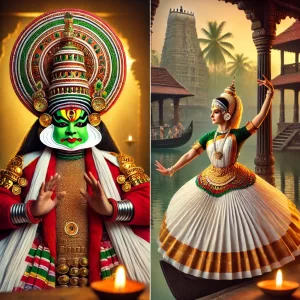
Globalization has reshaped how societies interact, communicate, and celebrate cultural traditions. In Kerala, a state renowned for its vibrant festivals, classical art forms, and deep-rooted heritage, globalization has brought both opportunities and challenges. As international influence grows, Kerala’s cultural festivals are evolving in form, content, and participation.
This blog explores how globalization is influencing Kerala’s festivals—from language and attire to tourism, media, and the preservation of traditions—while maintaining a balance between modernity and heritage.
A Glimpse into Kerala’s Traditional Festivals
Kerala’s cultural identity is richly expressed through festivals such as Onam, Thrissur Pooram, Vishu, and Theyyam. These festivals celebrate seasonal changes, religious beliefs, and social unity.
Traditionally, they include:
-
Rituals in temples and homes
-
Classical art forms like Kathakali, Mohiniyattam, and Chakyar Koothu
-
Traditional attire like kasavu sarees and mundus
-
Local languages, especially Malayalam, as the medium of communication
However, globalization is changing how these elements are celebrated and perceived.
Influence of Global Tourism
Globalization has brought Kerala into the spotlight as a major cultural tourism destination. Tourists now travel from around the world to witness grand festivals like Thrissur Pooram and Onam celebrations.
Positive impacts include:
-
International recognition of Kerala’s cultural diversity
-
Boost in local economy and tourism-related jobs
-
Promotion of traditional art, food, and rituals
However, increased tourism also leads to challenges:
-
Over-commercialization of events
-
Rituals modified for tourist-friendly experiences
-
Pressure on local infrastructure during peak seasons
Shift in Language and Communication
With English becoming a dominant global language, many festival announcements, brochures, and speeches are now bilingual. While this increases accessibility, it sometimes sidelines Malayalam, the native language.
Moreover, digital communication has transformed how people engage with festivals:
-
Social media platforms like Instagram and Facebook are used to promote events
-
Festival invitations are often sent via WhatsApp or email
-
Live streaming of rituals allows global participation
Although digital tools expand outreach, they may reduce face-to-face community bonding that was once central to festival culture.
Changing Festival Attire and Materials
Traditional festival clothing, such as the kasavu saree or mundu, is increasingly being replaced by modern or Indo-Western outfits, especially among the youth. In many cases, handcrafted materials are being substituted with mass-produced alternatives due to convenience and affordability.
This trend has two significant consequences:
-
Decline in demand for local artisans and weavers
-
Loss of the visual and cultural authenticity of festivals
Transformation of Art and Performances
Globalization has influenced the way traditional art forms are performed. Classical dances and ritual arts are now being shortened or altered to suit stage shows or foreign audiences.
For example:
-
Kathakali performances are compressed into 30-minute sessions
-
Fusion music and dance blend Western and Indian styles
-
Ritual art forms are adapted for television or YouTube content
While these adaptations help artists reach wider audiences, they sometimes dilute the original meaning and context of the performance.
Youth Participation and Cultural Continuity
Earlier, children learned rituals, songs, and dances from elders and participated in every aspect of festivals. Today, due to the influence of modern education, urbanization, and technology, younger generations are more disconnected from traditional practices.
However, this gap is also being addressed through:
-
School programs on local culture
-
NGO-led workshops on festival traditions
-
Digital platforms showcasing traditional knowledge
These efforts aim to revive interest among the youth while using tools they are familiar with.
Commercialization of Celebrations
Globalization has introduced corporate sponsorship into festival spaces. While funding from businesses helps in organizing large-scale events, it also brings branding and advertisements that sometimes overshadow the spiritual or cultural focus.
Examples include:
-
Stage banners with logos of sponsors
-
Product promotions during rituals or parades
-
Media coverage emphasizing celebrities over cultural depth
This shift raises concerns about the commodification of heritage for commercial benefit.
Urban Development and Festival Spaces
As Kerala’s cities grow, traditional festival spaces are shrinking. Urban expansion often results in:
-
Procession routes being rerouted
-
Traditional temple grounds converted or repurposed
-
Noise restrictions limiting musical and dance performances
Moreover, indoor auditoriums are replacing open-air venues, changing the atmosphere of community participation. This affects both the ritualistic depth and visual aesthetics of festivals.
Cross-Cultural Exchange and Adaptation
Globalization also encourages cultural exchange, with Keralites living abroad celebrating festivals in the UAE, the US, or Europe. This has led to:
-
Adaptation of festivals to new cultural settings
-
Increased diaspora involvement in traditional events
-
Hybrid celebrations that combine local and global elements
Such practices ensure cultural continuity while showcasing Kerala’s heritage on international platforms.
Efforts to Preserve Kerala’s Cultural Identity
Despite these shifts, many organizations and individuals are working to preserve Kerala’s cultural festivals in their authentic form. Notable initiatives include:
-
Kerala Tourism’s campaigns promoting sustainable, traditional festivals
-
Folk arts academies train young artists in ritual performances
-
Digital archives documenting traditional knowledge and oral histories
Additionally, some communities adopt a balanced approach, integrating modern tools while staying rooted in tradition.
Conclusion
The impact of globalization on Kerala’s cultural festivals is both transformative and complex. It has opened new doors for global recognition, tourism, and innovation, while also raising concerns about authenticity, commercialization, and cultural dilution.
However, Kerala’s ability to adapt while preserving its identity stands out. By embracing globalization with cultural sensitivity, the state continues to celebrate its festivals in ways that are inclusive, vibrant, and deeply meaningful—not just for Keralites, but for the global community as well.

Leave a Reply